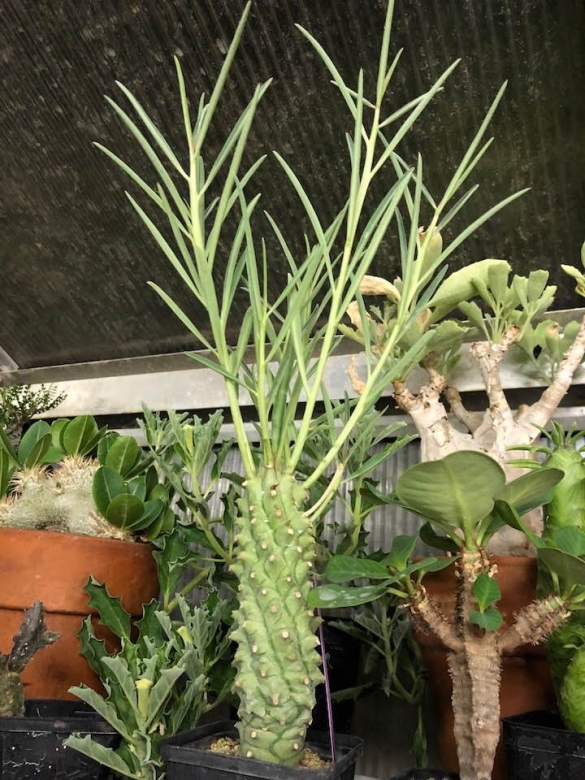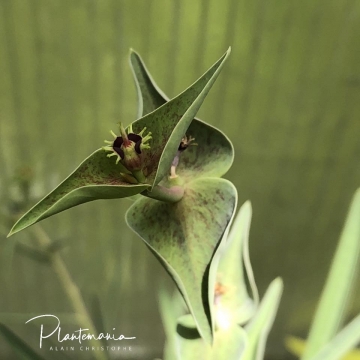
Euphorbia monteiroi Photo by: © Plantemania
Origin and Habitat: Euphorbia monteiroiSN|35325]]SN|35325]] is a tropical species which occurs in Angola, Namibia, Botswana, Southern Africa (Transvaal) and western Zimbabwe.
Altitude range: 1,000 - 1,070 metres above sea level.
Habitat and ecology: This species grows on sandy soils and limestone outcrops in open and sparsely vegetated plains and wooded grassland together with Hoodias and other succulents.
Synonyms:
See all synonyms of Euphorbia monteiroi
Description: Euphorbia monteiroi (aka Euphorbia monteiri or Euphorbia monteroi) is a perennial, succulent herb or shrubs to 1 m (usually less than 30 cm tall). This species is unique in several ways, it has a swollen "cabbage stump" stem from a woody rootstock. The leaves on this basal part are long and thin. After rain, the tuberculate stem produces a crown of thin, leafy, deciduous inflorescences with a small dark-red flower on the tips. The long peduncles (stems of the inflorescences) eventually wither and persist, as spines for several seasons, curving over the top of the plant and form a useful canopy from the burning sun. The flowers are borne on long, thin branches with leaves which gradually become shorter. The roots are occasionally rhizomatous, branching below ground to form spreading plants. A white latex is exuded from points of injury anywhere on the plant
Stem: Cylindrical to 10 cm in diameter, simple or occasionally sparingly branched above usually only when damaged, covered with more or less prominent crowded tubercles (arranged in a close spiral),
Leaves: Linear-elliptic, usually petiolate, 5–21 times as long as wide, up to 21 cm long and 3 cm wide, petiole to 1 cm long.
Inflorescences (cymes): 3-5 at the axils of the leaf bases, often umbellately branched above; umbel often branched (2- to 8 forked), on leafy peduncles about 15-30 cm in length, rays about 7.5 cm long, alternately leafy, dying off and persistent. Paired bracts of the cymes usually longer than broad ( c. 3 × 2 cm) deltoid to ovate.
Flowers (Cyathia): 1 cm in diameter. Nectar-glands 4, elliptic, outer margin fringed with 3-6 short more or less lobed tiny 'fingers', red-brown to blackish purplish (very rarely green) .
Fruits (capsules): Subglobose, to 8 mm long and 12 mm broad, Pedicels 1 cm long, recurved.
Seeds: Ovoid, 5 x 3.5 mm, smooth.
Related species. E. monteiri is closely related to Euphorbia wildii which occurs on the Dyke soils in Zimbabwe, but its closest relative is probably Euphorbia longetuberculosa Hochst., common in southern Arabia. It has the same general appearance, but it becomes at the most 20 cm tall; the dorsiventral cyathia are small and insignificant.
Subspecies, varieties, forms and cultivars of plants belonging to the Euphorbia monteiroi group
 Euphorbia monteiroi Hook.: has a thickened stem up to 300 mm tall and 100 mm in diameter that produces a crown of thin, leafy, deciduous inflorescences with a small dark-red flower on the tips. These wither and persist as spines for several seasons. Dustribution: Angola, Namibia, Botswana, Southern Africa (Transvaal) and western Zimbabwe.
Euphorbia monteiroi Hook.: has a thickened stem up to 300 mm tall and 100 mm in diameter that produces a crown of thin, leafy, deciduous inflorescences with a small dark-red flower on the tips. These wither and persist as spines for several seasons. Dustribution: Angola, Namibia, Botswana, Southern Africa (Transvaal) and western Zimbabwe.- Euphorbia monteiroi subs. brandbergensis B.Nord.: Its stem is taller from 1-2 m tall with rounded apex and an open tuberculate pattern. The peduncles are shorter with narrower bracts. Nectar glands usually 5, yellow-green, marginal processes longer. Distribution: N Namibia.
- Euphorbia monteiroi subs. ramosa L.C.Leach: up to 30 cm hight with branched stems. Stem and branches more slender, Tubercles in looser spirals. Leaves shorter. Bracts wider than long. Distribution: SE Botswana and South Africa (Mpumalanga).
Notes: The original species' epithet for Euphorbia monteiroi was “monteiri”. Hooker deliberately latinized Monteiro as `Monteirus' giving rise to the appellative “monteiri”. The old name Euphorbia monteiri is still used in many books.
Bibliography: Major references and further lectures
1) Hermann Jacobsen “Abromeitiella to Euphorbia” Blandford Press, 1960
2) Werner Rauh, “The Wonderful World of Succulents: Cultivation and Description of Selected Succulent Plants Other Than Cacti” Smithsonian Institution Press, 1984
3) Botanical Society of South Africa, “Journal of the Botanical Society of South Africa”, Parts 36-37, Botanical Society of South Africa., 1950
4) National Cactus and Succulent Society, “The National Cactus and Succulent Journal: The Official Journal of the National Cactus & Succulent Society”, Volumes 3-6, National Cactus and Succulent Society, 1948
5) Leffers A. “Gemsbok Bean and Kalahari Truffle”, Gamsberg MacMillan; Namibia. 2003
6) “Flora Zambesiaca” Website: http://apps.kew.org/efloras/fz/intro.html
7) “Protabase - Plant Resources of Tropical Africa.” Website: http://www.prota.org
8) “Kirkia”, Volume 6, Department of Research and Specialist Services, Ministry of Agriculture, 1967
9) Tropical Plants Database, Ken Fern. tropical.theferns.info. 2018-08-26. <tropical.theferns.info/viewtropical.php?id=Euphorbia+monteiroi>
10) Doreen Bolnick “A Guide to the Common Wild Flowers of Zambia and Neighbouring Regions” Macmillan Zambia, 1995
11) S. Carter & L.C. Leach, “Flora Zambesiaca” FZ, Vol 9, Part 5, 2001
12) Urs Eggli "Illustrated Handbook of Succulent Plants: Dicotyledons" Volume 2. Springer, 2002
 Euphorbia monteiroi Photo by: © Plantemania
Euphorbia monteiroi Photo by: © PlantemaniaSend a photo of this plant.The gallery now contains thousands of pictures, however it is possible to do even more. We are, of course, seeking photos of species not yet shown in the gallery but not only that, we are also looking for better pictures than those already present.
Read More... Cultivation and Propagation: E. monteiroi grows quickly in cultivation.
Exposure. Requires a sunny position.
Soil: Requires a well-drained soil
Medicinal uses: The plant is traditionally harvested from the wild for local medicinal uses. The thick, lateral roots are cut into slices and added to boiling milk. This liquid is said to purify the blood and to be a tonic for the metabolism.An infusion of the crushed roots is drunk as an emetic and purgative. A leaf and root decoction is taken to treat biliousness. A latex obtained at points of damage to the plant is applied to decaying teeth.
Warnings: The latex in most, if not all Euphorbias is caustic and toxic - skin contact often causing irritation and blistering; contact with the eyes causing temporary or even permanent blindness; whilst ingestion can cause purging or more severe problems.











